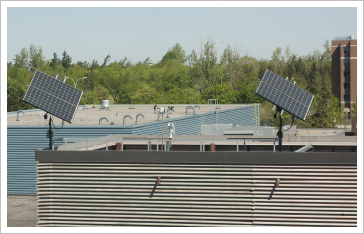 Working with solar arrays installed on Fanshawe buildings, researchers in the College’s Centre for Sustainable Energy and Environments have created a predictive model to help off-grid power producers decide when to sell and bank their power.
Working with solar arrays installed on Fanshawe buildings, researchers in the College’s Centre for Sustainable Energy and Environments have created a predictive model to help off-grid power producers decide when to sell and bank their power.
Ontario residents can now sell solar-generated power back to the power grid. This is one way to save money on your hydro bill – assuming you've got the resources to install a solar array on your property.
But there's another way these individual solar arrays may help lower electricity costs across the board in the future. Off-grid producers are licensed to sell their power back to the grid at a fixed price. In contrast, prices for grid-sourced power fluctuate according to supply and demand – when demand is high, the power costs more. If local utilities like London Hydro can purchase some of the power they need during peak-load times from individual residents, it means they don't have to buy it at the higher market price from the grid itself. They also don't have to invest heavily in building new power-production facilities.
The problem is, individual residents aren't yet able to store the power collected through their solar arrays. So whatever isn't used to run toasters and air conditioners gets fed back to the grid on the same sunny day it was collected.This, in turn, means the local utility can't reliably predict when or how much power it can buy from non-grid sources.
This will change once power-storage technology progresses, as it has in parts of Europe. Eventually, individual solar-array owners will be able to"bank" their power, either saving it for a rainy day, or selling it back to the local utility at the precise moment it's most needed.
Looking ahead to this scenario, London Hydro recognized the need for some sort of control method to help off-grid power producers decide when to sell and when to bank their power. Such a decision would have to take into consideration how much power could predictably be gathered and stored, as well as when peak power loads would occur and how much the market price for grid-purchased power would fluctuate. Knowing of Fanshawe's capability for performing this type of research, London Hydro turned to the CSEE for help.
Professor Martin Volkening of the School of Applied Science and Technology and Dr. John Makaran, Industrial Research Chair, were asked to head up the three-year project, assisted by three co-op students. Working with a campus-based solar array, the team's aim was to develop a predictive model to marry fluctuating energy costs and load predictions with climate-prediction data from Environment Canada.
"The model we've developed factors in both present and predictive cloud-cover, based on images taken with a fish-eye camera mounted on our roof, as well as data from Environment Canada," says Dr. Makaran.
Results from this investigation have been utilized in subsequent research projects and have proven invaluable in giving students the opportunity to work with emerging technologies.
"The most important thing for us is finding ongoing ways to engage our students," says Dr. Makaran. "Yes we're doing some interesting and very valuable research, but what we're really doing is educating students and providing highly qualified professionals."
Funding for this project was provided by the Colleges Ontario Network for Industry Innovation (CONII) and the Natural Sciences and Engineering Research Council of Canada.
For information about the Centre for Sustainable Energy and Environments, please contact research@fanshawe.ca
